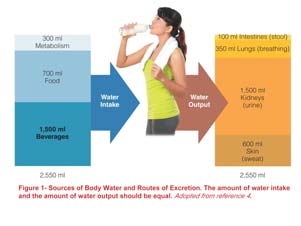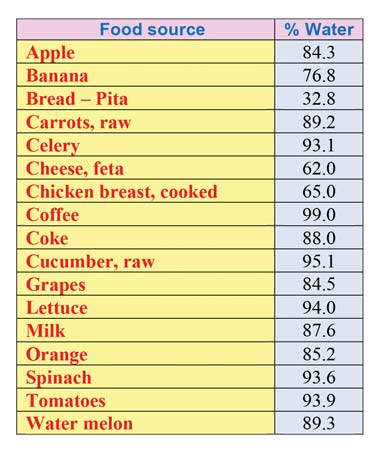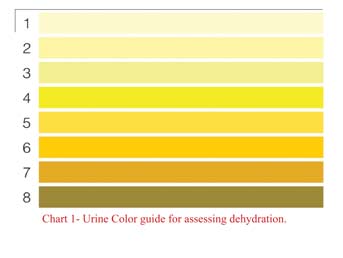Educational Series
The Science of Nutrition
By: Mohammad Ahrar, PhD
Introduction
Anytime the subject of nutrition comes up, we usually think about fats (see discussion in Peyk ##159-161), proteins (Peyk #162), carbs (Peyk #165), vitamins (Peyk ##169-174), and minerals (Peyk #175), but we hardly talk about water. In this issue of Peyk, we will discuss the importance of water in the human body and why water is essential to life.

Bodily water composition
The amount of water in the body depends on age, gender, and physical activity. The approximate percentage of water in men is 60-65%, in women is 50-54%, and in infants is approximately 75%. About 2/3 of the water is inside cells, referred to as intracellular fluid (ICF), and only one third is outside the cells, referred to as extracellular fluid (ECF), mainly in the blood and lymph nodes, plus fluids surrounding the brain, spinal cord, in joints, and in other organs.
Sources of water in the body
Beverages and food are the major sources of water for the body. Beverages comprise the largest source, but most foods can also contribute to meeting daily water needs (Table 1). Besides the water intake from foods and drinks, some water is also generated in the body during cellular metabolism, referred to as metabolic water. This happens when your body is producing fat, proteins, and some other organic compounds. For example, synthesis of 1 gram of fat produces 1.07 grams of water. Maybe that is a reason camels can go without water for a long period of time! All these water sources (beverage, foods, and metabolic water) contribute to about 2,550 ml of water in the body.

Table 1: Water content in some foods
Water loss from the body
The majority of fluid lost from the body is through the kidneys, which produce approximately 1,500 milliliters of urine each day. Another way of water loss is through sweat which varies based on environmental factors, such as temperature, and the amount of physical activity a person does. The body also loses about 200 to 400 milliliters of water per day through the skin and during breathing (referred to as insensible water loss), and some water is lost from the large intestine.
The role of water in the body
In short, no life can exist without water. A water molecule (H2O) has a unique chemistry (polar covalent bond between oxygen and hydrogen atoms) that makes it possible for all living organisms to live.
Most chemical reactions that occur inside the cells require water. Digestion of food and breakdown of large molecules into smaller molecules during digestion and cellular metabolism require water; production of energy to sustain life cannot be done without water. Brain functions, heart performance, hormone production by endocrine glands, and all metabolic activities in the liver depend on water. Without water, the joints would be stiff and nonfunctional, muscles could not function, and transport of dissolved materials such as oxygen, nutrients, hormones, and other substances into and out of the cells—and throughout the body—depends on water. In other words, life would cease without water. When the amount of water consumed is equal to the amount excreted, the body is in water balance.
Amount of water needed per day
The amount of water a person needs depends on physical activity, diet, and environmental factors such as air temperature. However, no single formula fits everyone. According to a Mayo Clinic report, an adequate daily fluid intake is about 15.5 cups of fluids for men, and about 11.5 cups for women. These recommendations cover fluids contained in both beverages and food. About 20 percent of daily fluid intake usually comes from food and the rest comes from drinks.
You’ve probably heard the advice “drink eight glasses of water a day.” That’s easy to remember, and it’s a reasonable goal.
(1 glass of water = 8 Oz., equals to 250 milliliters.)
Dehydration
Dehydration occurs when there is an insufficient amount of water in the body due to reduced fluid intake, or to the loss of water through excessive sweating, or as a result of diarrhea, vomiting, high fever, or use of diuretics.
Signs of dehydration- Thirst is often the first physical sign of dehydration. Other signs include dry mouth, fatigue, loss of short-term and long-term memory, and lower attention span and cognition. Dehydration causes a reduced blood volume and blood pressure (hypotension). Hypotension, if severe enough, results in reduced cardiac output, impaired digestion, and fainting or blackout. Dehydration in infants can be very critical and needs immediate attention.
A practical way to see if you are well hydrated is to pay attention to the color of your urine. If the color of urine is dark, that is a sign of not enough water in your body. If the color of urine is brown, it needs medical attention. The urine color chart below can be used as a guideline to assess hydration.
How the body controls water balance
The kidneys play a key role in regulating blood volume, as well as electrolyte balance through tightly controlled hormonal signals. When blood volume drops, the thirst center in the hypothalamus detects a decrease in blood pressure and the change in electrolytes, and you begin to feel thirsty. At the same time a hormone called Anti Diuretic Hormone (ADH) is released from the posterior pituitary gland. This hormone travels through the blood to the kidneys and stimulates reabsorption of water from the kidney tubules back into the blood stream to conserve water. This results in less urine output and a darker urine. The urine color guide shown below, suggested by The National Athletic Trainers Association, can be used as a guide for proper hydration. Clear or light-yellow urine (colors 1 and 2) indicates adequate hydration. Dark urine (colors 7 and 8) indicates dehydration and the need to consume more fluid.

Regulation and sources of tap and bottled water
Water sources vary from faucet to faucet and bottle to bottle. In the United States, tap water (the water that comes from sink faucets) is generally clean and safe to drink. The sources of tap water in most cities and communities can be underground, wells or springs, rivers, lakes, or reservoirs. Regardless of the source, municipal water is sent to treatment plants where dirt and debris are filtered out, bacteria are killed, and other contaminants are removed. Billions of dollars have been invested in water treatment systems to ensure that public water is safe to drink. People who drink tap water may also get some fluoride in their water which can reduce the incidence of dental cavities. The Environmental Protection Agency (EPA) oversees the safety of public drinking water.
Bottled water should be safe to drink. The U.S. Food and Drug Administration (FDA) regulates bottled water and sets the standard of identity. All bottled water must be labeled. If the label on the bottle states that it is “spring water,” the manufacturer must derive the water from a very specific source, such as a spring or a well. Some bottled water may actually come from a municipal water source. This bottled water must also adhere to a standard of quality set forth by the FDA. However, water that is bottled and sold within the same state is not regulated by the FDA. The main concern about bottled water is the cost of production and the contamination to the environment. Some bottles are reused and refilled and may not be thoroughly cleaned. Some may have stayed in storage or under the sun for a long period of time, and there is a possibility that chemicals leak from the plastic of the bottle into the water. The bottom line is that both tap water and bottled water can be safe to drink, and the choice is likely to come down to personal preference, costs, and concern about environmental impacts.
“Hard” water
The “hardness” of water refers to the amount of minerals—specifically calcium and magnesium—in water. The higher the amount, the “harder” the water. There aren’t any health concerns from drinking hard water. In fact, hard water may even contribute small amount of minerals to the diet. For example, calcium, phosphorus, and magnesium, which can be found in tap water, are essential for building bones and teeth. Calcium is also essential for muscle contraction, nerve impulses, releasing hormones, blood clotting, and maintaining a normal heartbeat.
Consuming too much water
Although water is an essential nutrient, it can also be harmful if consumed in excess. Drinking too much fluid, especially demineralized water, and drinking it too fast can cause water intoxication. When too much water enters the cells, the tissues swell with excess fluid, while the concentration of sodium surrounding the cells drops, resulting in a condition referred to as hyponatremia which means low sodium in blood.
The brain is very sensitive to electrolyte change. When the fluid outside the cells is diluted, electrolytes inside the cells become more concentrated and water rushes from outside the cells into the cells which causes the tissues to swell to the point of bursting. If the swelling occurs in brain cells, it may cause death.
Symptoms of water intoxication include fatigue, confusion, and disorientation. Mistakenly treating these symptoms by consuming more water only makes matter worse. This has happened to some marathon runners who didn’t have time to use the bathroom, resulting in death. Drinking mineralized or enhanced water can supply both water and electrolytes during physical activities.
Tea and coffee as water substitutes
Easy answer; if you make tea or coffee with water, then they can substitute water. Both tea and coffee contain about 99% water, and moderate consumption of them can substitute almost the same amount of water. Caffeine is a mild diuretic and blocks the action of ADH in the kidneys, but it does not cause a significant loss of body water over the course of the day.
Effect of alcohol on water balance
Alcohol interferes with water balance by inhibiting ADH in the kidneys. The water loss affects electrolyte concentration, especially potassium which in turn affects metabolism. Reducing the amount of alcohol consumed and drinking water after consuming alcohol can help prevent dehydration and a hangover, which is a result of dehydration.
Summary
Water in the body of an adult is about 54 to 65%, and in infants 75%. The main sources of water in the body are from beverages, foods, and metabolic water. Tap water and bottled water are both safe to drink, and the choice is personal preference. Tea and coffee can substitute for water.
Selected References:
1- Nutrition: From Science To You, 3rd ed., Joan Salge Blake, Kathy D Munoz, and Stella Volpe, Pearson Education, Inc. (2016).
2- http://www.foodnutritiontable.com/nutritions/
3- https://www.smithsonianmag.com/smart-news/there-are-372-trillion-cells-in-your-body-4941473/
4- Nutrition and Diet Therapy: Evidence-Based Applications, 4th ed., Lutz, Carroll and Przytulski, K., F. A Davis Company, Philadelphia (2006).
5- https://www.mayoclinic.org/healthy-lifestyle/nutrition-and-healthy-eating/in-depth/water/art-20044256


















